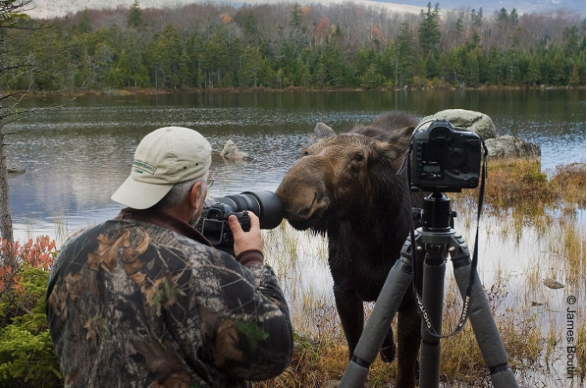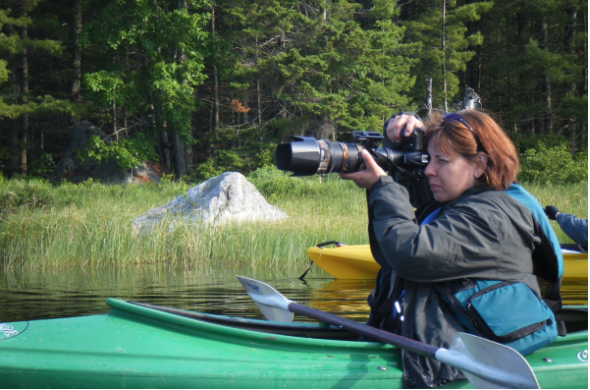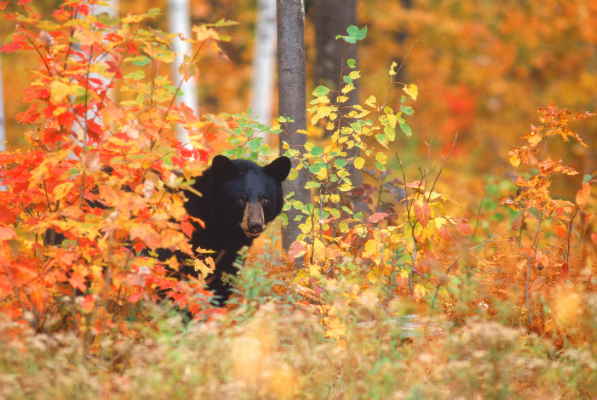Anita Mueller and Mark Picard are professional wildlife and landscape photographers located in Millinocket, Maine, or, more importantly, at the doorstep of Baxter State Park. They are partners in Moose Prints Gallery, which features stunning photographs that they have taken over the years, and the Springfield Photographic Society had an opportunity to talk with them about photography in Maine.
SPS You both have Western Massachusetts roots. How did you meet?
Mark I was born and raised in Easthampton, living in the “hill towns” until 2010 when I moved up here to Millinocket where I had been traveling to photograph since 1980.
Anita I grew up in Enfield and met Mark at Fannie Stebbins (Memorial Wildlife Refuge). He was already an Internationally published wildlife photographer running workshops locally and in Maine, I was photographing as a hobby at the time, and we started talking. One thing led to another, and we wound up in Millinocket.
SPS Wildlife and landscape photography are related, yet also different. What are some of the approaches someone should take when setting out to take photographs in each genre?
Mark You should find your passion. Having a passion for your subject is the most important thing. I could have been a wedding photographer, but I hate weddings and would not have done a good job at it. When you are starting off, start taking different photographs and see what you like. Every picture is a story, and I love wildlife and landscape photography, so that is my passion.
Anita Decide what story you want to tell with your photograph. That will help a lot with your composition and what you are shooting. What are you trying to say? Whether you have thought it out before you pressed the shutter or it is in the moment, your pictures will tell a story.
SPS Why moose? What drew you to photographing and specializing in moose?
Mark I don’t know, there is something about it. It looks like a bunch of different animals put together in one funny-looking beast, I love it.
SPS How much preparation should someone do before going out into the field?
Mark Know your equipment, inside and out, especially when photographing wildlife. It should be second nature. You don’t want to be fumbling with your settings when a moose comes running by. You aren’t going to get it. Also, study up on your subject, and find out where they eat, what they eat, and when they mate. Like landscape (photography), you aren’t going to go to a place without knowing if it will be a good shoot. It’s the same for wildlife.
SPS How big a role is planning versus serendipity, or chance, in getting “the shot”?
Mark Chance plays more of a role than you can imagine. We probably get a 10 percent hit rate and a 90 percent failure rate. Sometimes, I’ll wind up with a shot of a chipmunk (instead of what was planned). And yes, there are people that will buy stock photos of a chipmunk. I’ll photograph anything with four legs and fur.
SPS Without getting into the weeds on equipment, what are some of the basic pieces of equipment that someone should think about when photographing wildlife or landscapes?
Mark A medium telephoto zoom lens is a good one (100 mm to 400 mm). You can’t get by with a 50 or 100 mm. A decent camera, it doesn’t have to be the best, and a good tripod. Many people don’t want to use a tripod, but it is important, especially for landscape.
I have only three lenses now. I used to have all the lenses in the world, but I’ve gotten smarter about what I’m packing when I head out. Especially with post-processing, it doesn’t have to be the exact, perfect lens anymore.
Anita A better camera isn’t necessarily going to make you a better photographer. In our workshops, we see great shots taken with cell phones. It’s the photographer, not necessarily the camera.
Mark With digital, you can now take a lot of photos easily, so you have to cull ruthlessly (when reviewing your photos). With wildlife, I do “spray and pray.” You never know which shot is going to be the right one. It could be the eighth one.
I only use polarizer filters now because of what Lightroom and Photoshop can do. I’m able to extract what I need with those programs; I don’t need a graduated filter anymore.
SPS Patience certainly plays a big role in getting “the shot,” doesn’t it?
Mark Yes, it does. Sitting in a blind, you can’t nap, you can’t read, you have to be peering out of these little portals. I spent three weeks in a blind where bears were, waiting for a photograph. When I started, the leaves were green, and by the time I got the picture, the leaves had started turning, which gave me a great shot. I’ll spend so much time in a blind that when I leave it, I’ll leave a shirt in it with my scent so that the animals get used to it, and after two or three days, it’s normal to them.
And you have to be so quiet. I wish they had mirrorless cameras years ago. I have missed so many shots because the animal heard the click (of the shutter) and was gone.
SPS What about when you are taking a landscape photograph and your result just doesn’t match what you saw when you clicked the shutter?
Mark It’s called “Lightroom” and “Photoshop.” The camera is trying to turn everything to 18 percent gray. It is going to try and average everything out. You need to shoot in RAW (format). The information is still there. You need to tweak it. You want to make both local and global adjustments to bring the information out and extract it from the shot. To be a good photographer, you should master these programs; everyone is doing it. If they say they aren’t, they really are or should be.
SPS A landscape photograph doesn’t necessarily have to be a grand vista shot with a wide angle, does it?
Mark No, it can be intimate, it can be the trees or a brook.
Anita You can use a long lens and stitch the photographs together. A wide-angle lens pushes things away from you, making them appear smaller, and a long lens will compress things. You can take a series of photographs with a long lens and stitch them together to get a wide shot. Mark will shoot at 70 (mm), vertically, and then when they are put together, they will have that wide-angle look.
Mark If you could only have one lens, I would drop the wide angle and go with a telephoto. You can simulate a wide angle with a telephoto and get the same result. You can’t go the other way.
SPS How important is a clock as part of your equipment?
Mark You have to force yourself, if you aren’t a morning person, to get the shot. You can always nap during the middle of the day when the light is harsh.
Anita For our June workshops, it took us a while to figure out that we should have dinner at 3:00 pm because we were running all day, from early in the morning until last light. This way, participants can eat and get back out shooting and then have a snack or dessert at night if they need to.
SPS Thanks for taking the time to talk with us!
Mark and Anita own Moose Prints Gallery (www.mooseprintsgallery.com) in Millinocket, Maine, that features a wide selection of photographs from Maine. Anita runs a series of workshops in the area on both land and water that feature opportunities to photograph the woods coming to life along with moose and their newborn calves.



